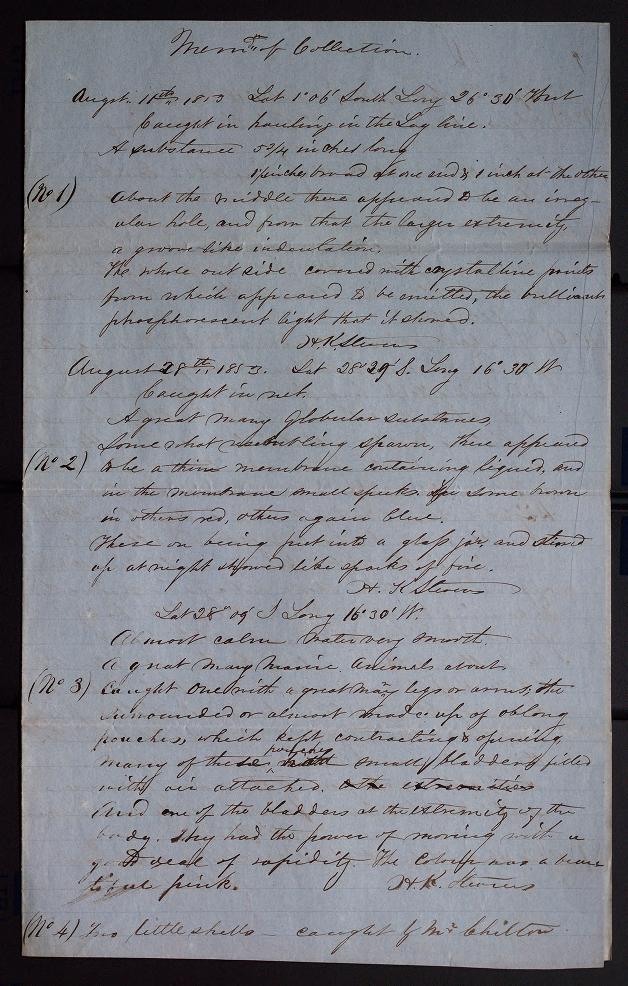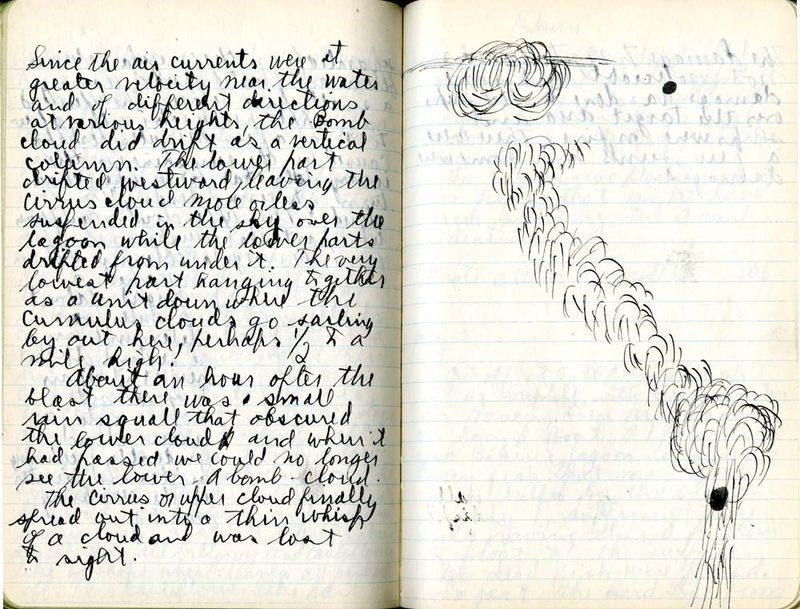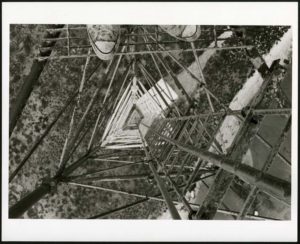Contents:
Sailing and Science
A Cruise with a President
The Atomic Era
U.S. Navy Navigation
To learn more
Lesley Parilla
Cataloging and Bibliographic Access Librarian, Smithsonian Libraries
A researcher might not think to look for materials relating to the U.S. Navy at the Smithsonian Institution, however, the Institution holds numerous collections documenting the U.S. Navy and U.S. naval history, due to its long history of collaboration. Since the Smithsonian’s founding in 1846, it has served as a repository for natural history specimens resulting from the maritime surveys and expeditions frequently run by the U.S. Navy. Into the twentieth century, the U.S. Navy’s ability to travel to far flung locations meant that naturalists often ended up aboard, sometimes by government request, sometimes through personal connections. In many cases, the papers related to those expeditions ended up in the Smithsonian Institution Archives, and document not only the research of the Smithsonian Institution but also the history and operations of the U.S. Navy.
These collection materials are now easier to locate through the Field Book Project, a grant-funded project organized by Smithsonian Institution Archives, Smithsonian Libraries, and National Museum of Natural History, which ran from 2010 to 2018. The project focused on locating, identifying, and describing, and increasing access to the field notes of naturalists. As a result archival collections from across the Smithsonian describing major nineteenth century Navy expeditions and twentieth century Navy cruises are easier to discover and explore.
Sailing and Science
As the U.S. expanded its territorial and commercial interests during the nineteenth century, military personnel worked with Smithsonian staff during expeditions like the United States North Pacific Exploring Expedition (1853-1856). Led by Captains Cadwalader Ringgold (1853-1854) and John Rogers (1854-1856), the expedition surveyed the Bering Straits, coasts of China, Japan, and California, Madeira Island and Tahiti. Collection materials in SIA RU7222 also document fieldwork completed by U.S. Navy personnel. For example an officer, Lieutenant H.R. Stevens, struggled to find language to describe what appears to be an example of bioluminescence:
[August 28th, 1853] Caught in net. A great many globular substances. Somewhat resembling spawn. These on being put into a glass jar and stirred up at night showed like sparks of fire.
Similar expeditions continued until near the end of the century, when the U.S. government established agencies including the U.S. Geological Survey and U.S. Fish and Wildlife that assumed responsibility for documenting the nation’s natural resources.

Page from H.R. Stevens Notes, United States North Pacific Exploring Expedition (1853-1856), United States North Pacific Exploring Expedition, (1853-1856) Records, 1852-1861 and undated, Biodiversity Heritage Library Field Notes Project, Smithsonian Institution, SIA RU007253.
A Cruise with a President
The Smithsonian’s relationship with the U.S. Navy continued and evolved into the twentieth century; more work with the U.S. Navy originated through personal contacts and relationships. In 1938, President Franklin D. Roosevelt, former Assistant Secretary of the Navy, invited Invertebrate Zoologist Waldo Schmitt to join the Presidential Cruise of 1938 aboard the USS HOUSTON. The ship traveled from California, in route to the Galapagos Islands, via the Panama Canal. Waldo’s invitation may have been related to his reputation as a friendly and outgoing individual, as well as his academic background. Schmitt’s personal papers (SIA RU7231) demonstrate someone who loved observing his surroundings and telling a good story. The collection includes a variety of field documentation and materials Schmitt saved from this experience, including correspondence, memorabilia like Plans of the Day from the U.S.S. HOUSTON, with a call to “Take heed all Spliney Shellbacks!” and images from ship events including the Shellback ceremony, as well as a detailed diary noting daily personal and professional activities.

Plan of the Day and photograph of Crossing the Line Ceremony, USS HOUSTON, 1938. SIA RU007231, Presidential Cruise of 1938: miscellaneous memorabilia collected by Waldo LaSalle Schmitt, Waldo L. Schmitt Papers, 1907-1978, Smithsonian Field Book Project.
The Atomic Era
The Smithsonian’s connection to the U.S. Navy also played out during less convivial times, when scientists accompanied U.S. Naval vessels as part of Operations Crossroads in 1946, and the resurvey in 1947. This U.S. Navy project sent scientists to the Marshall Islands to record observations before and after the Bikini Atoll atomic bomb tests of 1946. Naturalists included Leonard Peter Schultz an ichthyologist who collected fish and became one of the first scientists to observe the effects of the blast on the local fauna. Schultz’s personal papers (SIA RU700222), include personal observations on of his time at sea including during the first atomic blast. Materials include a logbook, field notes, annotated maps, photographs, negatives, and 16mm films. Below is an image of his entry, written on “Able Day” (the day of the first atomic blast test at Bikini Atoll) describing his experience of watching the mushroom cloud.

Log of Crossroads Project by Dr. Leonard P. Schultz, Curator of Fishes, U.S. National Museum, 1946. Smithsonian Institution Archives, Record Unit 7222, Box 23, Folder: 1
U.S. Navy Navigation

National Museum of Natural History, Pacific Ocean Biological Survey Program Field Research Records, 1963-1967. Record Unit 245, National Museum of Natural History, Pacific Ocean Biological Survey Program Records, ca. 1961-1973.
During the 1960’s, the Smithsonian Institution took part in a decade long research program call the Pacific Ocean Biological Survey Program (SIA RU00245) that relied heavily on U.S. Navy resources and Department of Defense funding. Numerous staff were sent out on Navy vessels to do research at sea to document pelagic bird migration, and the result was more than a 1,000 items documenting time at sea and interactions with Navy personnel.
Some of this documentation even touches upon the modern history of navigation and specifically on the Long Range Navigation system known as LORAN. LORAN, originally developed by the US during World War II, and the later LORAN-C (now known as Loran-A or Standard Loran), served as the ground-based navigation system operated by the U.S. Coast Guard for the use of maritime and aviation traffic, and was indispensable to the U.S. Navy for decades until modern GPS navigation systems rendered the LORAN system obsolete.
As part of the program, staff spent time on Pacific Islands often only inhabited by U.S. Navy troops, including Sand Island. The island had a pretty uneventful history until the mid-twentieth century. Previously unoccupied, the location proved useful to the U.S. Navy and U.S. Coast Guard for several decades. During this time there were as many of 300 personnel on Sand Island, and its size was increased from 10 to 22 acres. As part of the project, staff used the LORAN tower to gain a different vantage point while photographing bird breeding areas, as seen in the photograph above, taken from the top of the tower. The result is a collection of photographs and other material formats documenting this little known island, heavily used by the U.S. Navy for decades.
To learn more
These examples represent just a portion of the holdings from archival collections documenting the Smithsonian-US Navy relationship. The collections, acquired from both formal and informal connections describe the professional and personal nature of the interactions between naturalists and U.S. Navy personnel through logbooks, diaries, photographs, charts and many other types of materials. These can be found across the Smithsonian Institution, at the Smithsonian Institution Archives, Smithsonian Libraries, and the National Museum of Natural History. To learn more about these and other collections, we encourage you to visit the Smithsonian’s Collections Search Center that enables researcher to search over 9.6 million records of the Smithsonian’s objects, archives, and library materials. A preliminary search for “U.S. Navy” returned over 1,000 results: http://collections.si.edu/search/results.htm?q=u.s.+navy and a search for “naval” over 34,000 results across the Smithsonian’s libraries, archives and collections.
Smithsonian Institution Archives, Field Book Project: https://siarchives.si.edu/about/field-book-project
To read more about Lesley’s work and the project: http://nmnh.typepad.com/fieldbooks/page/2/
(Return to September 2018 Table of Contents)

One Response to Inside the Archives: U.S. Naval History at the Smithsonian Institution